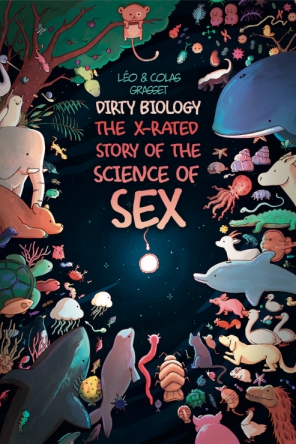 Dirty Biology
The X-Rated Story of the Science of Sex
Léo Grasset
Colas Grasset
Dirty Biology
The X-Rated Story of the Science of Sex
Léo Grasset
Colas Grasset
What is sex? Has it always existed? What purpose does it serve? Why are there penises and vaginas? These questions are at the very core of Dirty Biology, an erudite (and hilarious) graphic novel that aims to teach you everything you wanted to know about sex—and then some.
“Sex” can mean a number of things. It can refer to sex organs, to sex types, to the act of copulation, or to the simple exchange of genetic material. This book explains what we actually mean when we talk about sex and reveals a wealth of astonishing scientific details along the way. For example, did you know that some species can have sex without genitals? And when it comes to genitals, did you know that there’s an amazing diversity of these across species? From the evolution of penises and vaginas to far-fetched mating rituals and the shocking consequences of the sex act, Dirty Biology exposes sex for what it is: a lot more interesting and more complicated than the simplistic image we often have of it.
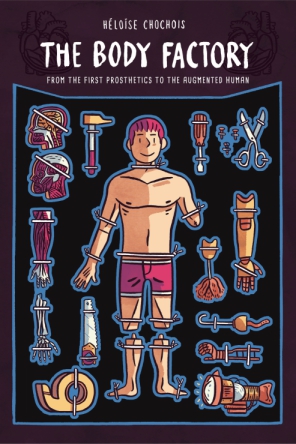 The Body Factory
From the First Prosthetics to the Augmented Human
Héloïse Chochois
The Body Factory
From the First Prosthetics to the Augmented Human
Héloïse Chochois
A young man has a horrible motorcycle accident. He wakes up in the hospital to discover that one of his arms has been amputated. Then a portrait on the wall of his hospital room begins to speak to him. The subject of the painting introduces himself as Ambroise Paré, the French barber-surgeon who revolutionized the art of amputation. From this wonderfully absurd premise, the two begin an imaginary conversation that takes them through a sweeping history of surgical amputation, from the Stone Age to the Space Age. Unencumbered by pathos or pedagogy, this graphic novel explores the world of amputation, revealing fascinating details about famous amputees throughout history, the invention of the tourniquet, phantom limb syndrome, types of prostheses, and transhumanist technologies.
Playfully illustrated and seriously funny, The Body Factory is sure to delight anyone interested in the history and future of medicine and how we repair—and even enhance—the body.
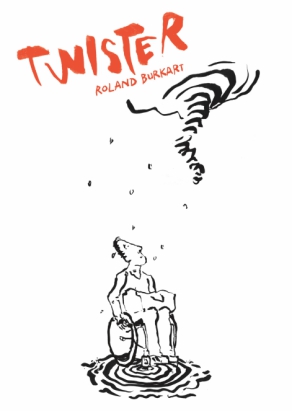 Twister
Roland Burkart
Twister
Roland Burkart
The last thing Piedro remembers is diving into the lake on his day off from work. Now he lies in a hospital bed with a wheelchair at his side. Casting a shadow from the doorway, his caretaker remarks on “how quickly one gets used to this kind of thing,” as she goes on to empty his catheter bag and to help him into his wheelchair.
Piedro must now deal with a growing mix of fear and powerlessness that surges within him as he realizes that he will be paralyzed forever; it bursts forth like a twister, “over and over again,” until he resigns himself to it. In time, Piedro’s feelings of hopelessness are offset by the realization that he can find both love and a degree of independence. With the support of his family and friends, he makes his way through rehab and finally gets back to the business of living.
Based on his own experiences, Roland Burkart’s Twister is a realistic and uplifting narrative that will resonate with anyone who has ever experienced or borne witness to a life upended by calamity.
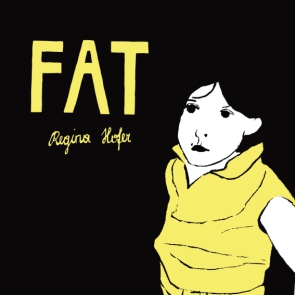 Fat
Regina Hofer
Fat
Regina Hofer
At sixteen, Regina began cutting back on meals to the point where her hair started to fall out. Later, she began to binge at night while her family slept. For a long time, she was able to keep her eating disorder a secret, though hiding her problem didn’t stop it from harming her emotional and physical well-being. The pressures of wanting to succeed as an artist led her to a nervous breakdown and, finally, a strong desire to start from scratch.
In Fat, Austrian-born author and artist Regina Hofer documents her battle with anorexia and bulimia. This powerful and imaginative graphic novel follows Regina from her childhood home in Upper Austria, where food and family mealtimes were often associated with feelings of personal failure, to art school at the Mozarteum University Salzburg and a violent reckoning with her dysfunctional family.
Vivid and courageous, this memoir will resonate with anyone living through or seeking to understand what it is like to live with an eating disorder.
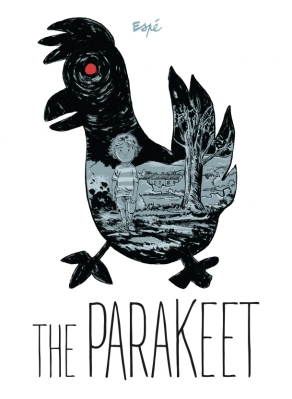 The Parakeet
Espé
The Parakeet
Espé
Bastien is eight years old, and his mother is ill. She often has what his father and grandparents call “episodes.” She screams and fights, scratches and spits, and has to be carted away to specialized clinics for frequent treatments. Bastien doesn’t like it when she goes, because when she comes home, she isn't the same. She has no feelings, no desires, and not much interest in him. According to the doctors, Bastien’s mother suffers from “bipolar disorder with schizophrenic tendencies,” but he prefers to imagine her as a comic-book heroine, like Jean Grey, who may become Dark Phoenix and explode in a superhuman fury at any moment.
Based on the creator’s own childhood experiences, The Parakeet is the story of a boy whose only refuge from life’s harsh realities lies in his imagination. In his eyes, we see the confusion and heartache he feels as he watches his mother’s illness worsen and the treatments fail. Through his eyes, we see how mental illness can both tear families apart and reaffirm the bonds of love. Poignant yet playful, The Parakeet follows Bastien’s struggle to accept the mother he has while wishing for the mother he needs.
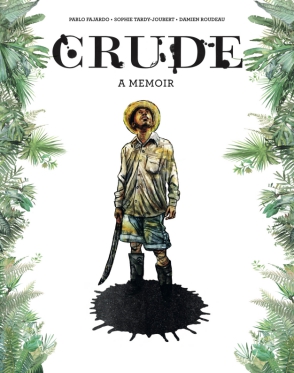 Crude
A Memoir
Pablo Fajardo
Sophie Tardy-Joubert
Damien Roudeau
Crude
A Memoir
Pablo Fajardo
Sophie Tardy-Joubert
Damien Roudeau
Oil waste was everywhere—on the roads, in the rivers where they fished, and in the water that they used for bathing, cooking, and washing. Children became sick and died, cases of stomach cancer skyrocketed, and women miscarried or gave birth to children with congenital disorders. The American oil company Texaco—now part of Chevron—extracted its first barrel of crude oil from the Amazonian Ecuador in 1972. It left behind millions of gallons of spilled oil and more than eighteen million gallons of toxic waste.
In Crude, Ecuadorian lawyer and activist Pablo Fajardo gives a firsthand account of Texaco’s involvement in the Amazon as well as the ensuing legal battles between the oil company, the Ecuadorian government, and the region’s inhabitants. As a teenager, Fajardo worked in the Amazonian oil fields, where he witnessed the consequences of Texaco/Chevron’s indifference to the environment and to the inhabitants of the Amazon. Fajardo mobilized with his peers to seek reparations and in time became the lead counsel for UDAPT (Union of People Affected by Texaco), a group of more than thirty thousand small farmers and indigenous people from the northern Ecuadorian Amazon who continue to fight for reparations and remediation to this day.
Eye-opening and galvanizing, Crude brings to light one of the least well-known but most important cases of environmental and racial injustice of our time.
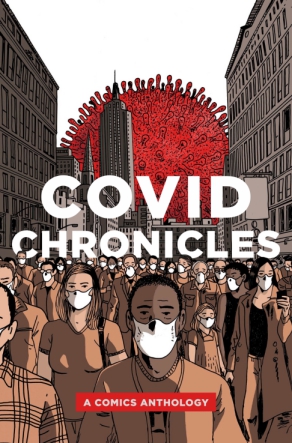 COVID Chronicles
A Comics Anthology
Kendra Boileau
Rich Johnson
COVID Chronicles
A Comics Anthology
Kendra Boileau
Rich Johnson
In 2020, the COVID-19 pandemic brought the world to its knees. When we weren’t sheltering in place, we were advised to wear masks, wash our hands, and practice social distancing. We watched in horror as medical personnel worked around the clock to care for the sick and dying. Businesses were shuttered, travel stopped, workers were furloughed, and markets dropped. And people continued to die.
Amid all this uncertainty, writers and artists from around the world continued to create comics, commenting directly on how individuals, societies, governments, and markets reacted to the worldwide crisis. COVID Chronicles: A Comics Anthology collects more than sixty such short comics from a diverse set of creators, including indie powerhouses, mainstream artists, Ignatz and Eisner Award winners, and mainstream media cartoonists. In narrative styles ranging from realistic to fantastic, they tell stories about adjusting to working from home, homeschooling their kids, missing birthdays and weddings, and being afraid just to leave the house. They probe the failures of government leaders and the social safety net. They dig into the racial bias and systemic inequities that this pandemic helped bring to light. We see what it’s like to get the virus and live to tell about it, or to stand by helplessly as a loved one passes.
At times heartbreaking and at others hopeful and humorous, these comics express the anger, anxiety, fear, and bewilderment we feel in the era of COVID-19. Above all, they highlight the power of art and community to help us make sense of a world in crisis, reminding us that we are truly all in this together.
The comics in this collection have been generously donated by their creators. Proceeds from the sale of this volume are being donated by the publisher to the Book Industry Charitable Foundation in support of comics shops, bookstores, and their employees who have been adversely affected by the pandemic.
